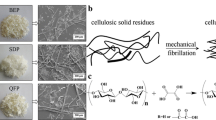Abstract
A softwood bleached kraft pulp (SBKP) and cotton lint cellulose were fully or partially mercerized, and these along with celluloses and commercially available regenerated cellulose fiber and beads were oxidized by 4-acetamido-TEMPO/NaClO/NaClO2 at 60 °C and pH 4.8. Weight recovery ratios and carboxylate contents of the oxidized celluloses were 65–80% and 1.8–2.2 mmol g−1, respectively. Transparent and viscous dispersions were obtained by mechanical disintegration of the TEMPO-oxidized celluloses in water. These aqueous dispersions showed birefringence between cross-polarizers, indicating that mostly individualized cellulose nanoelements dispersed in water were obtained by these procedures. Transmission electron microscopy observation showed that the cellulose nanoelements prepared from mercerized SBKP, repeatedly mercerized SBKP, mercerized cotton lint cellulose, regenerated cellulose beads and 18% NaOH-treated SBKP, i.e. partially mercerized SBKP, had similar morphologies and sizes, 4–12 nm in width and 100–200 nm in length. The 18% NaOH-treated SBKP was converted to cellulose nanoelements consisting of both celluloses I and II.





Similar content being viewed by others
References
Beck-Candanedo S, Roman M, Gray DG (2005) Effect of reaction conditions on the properties and behavior of wood cellulose nanocrystal suspensions. Biomacromolecules 6:1048–1054
De Souza Lima MM, Borsali R (2004) Rodlike cellulose microcrystals: structure, properties, and applications. Macromol Rapid Commun 25:771–787
Dong XM, Revol JF, Gray DG (1998) Effect of microcrystallite preparation conditions on the formation of colloid crystals of cellulose. Cellulose 5:19–32
Hirota M, Tamura N, Saito T, Isogai A (2009a) Oxidation of regenerated cellulose with NaClO2 catalyzed by TEMPO and NaClO under acid-neutral conditions. Carbohydr Polym 78:330–335
Hirota M, Tamura N, Saito T, Isogai A (2009b) Surface carboxylation of porous regenerated cellulose beads by 4-acetamido-TEMPO/NaClO/NaClO2 system. Cellulose 16:841–851
Hirota M, Furihata K, Saito T, Kawada T, Isogai A (2010a) Glucose/glucuronic acid alternating co-polysaccharides prepared from TEMPO-oxidized native celluloses by surface peeling. Angew Chem Int Ed 122:7836–7838
Hirota M, Tamura N, Saito T, Isogai A (2010b) Water dispersion of cellulose II nanocrystals prepared by TEMPO-mediated oxidation of mercerized cellulose at pH 4.8. Cellulose 17:279–288
Isogai A, Kato Y (1998) Preparation of polyuronic acid from cellulose by TEMPO-mediated oxidation. Cellulose 5:153–164
Isogai T, Yanagisawa M, Isogai A (2008) Degrees of polymerization (DP) and DP distribution of dilute acid-hydrolyzed products of alkali-treated native and regenerated celluloses. Cellulose 15:815–823
Isogai A, Saito T, Fukuzumi H (2011) TEMPO-oxidized cellulose nanofibers. Nanoscale 3:71–85
Langan P, Nishiyama Y, Chanzy H (2001) X-ray structure of mercerized cellulose II at 1 Å resolution. Biomacromolecules 2:410–416
Manjunath BR, Venkataraman A (1980) Fibrillar aggregation in cotton cellulose subjected to multiple swelling treatments with alkali. J Polym Sci Polym Chem Ed 18:1407–1424
Marchessault RH, Morehead FF, Walter NM (1959) Liquid crystal systems from fibrillar polysaccharides. Nature 184:632–633
Nelson ML, Tripp VW (1953) Determination of the leveling-off degree of polymerization of cotton and rayon. J Polym Sci 10:577–586
Nishiyama Y, Kim UJ, Kim DY, Katsumata KS, May RP, Langan P (2003) Periodic disorder along ramie cellulose microfibrils. Biomacromolecules 4:1013–1017
Okita Y, Saito T (2010) Entire surface oxidation of various cellulose microfibrils by TEMPO-mediated oxidation. Biomacromolecules 11:1696–1700
Saito T, Isogai A (2004) TEMPO-mediated oxidation of native cellulose. The effect of oxidation conditions on chemical and crystal structures of the water-insoluble fractions. Biomacromolecules 5:1983–1989
Saito T, Nishiyama Y, Putaux JL, Vignon M, Isogai A (2006) Homogeneous suspensions of individualized microfibrils from TEMPO-catalyzed oxidation of native cellulose. Biomacromolecules 7:1687–1691
Saito T, Kimura S, Nishiyama Y, Isogai A (2007) Cellulose nanofibers prepared by TEMPO-mediated oxidation of native cellulose. Biomacromolecules 8:2492–2496
Saito T, Hirota M, Tamura N, Kimura S, Fukuzumi H, Heux L, Isogai A (2009) Individualization of nano-sized plant cellulose fibrils by direct surface carboxylation using TEMPO catalyst under neutral conditions. Biomacromolecules 10:1992–1996
Saito T, Hirota M, Tamura N, Isogai A (2010) Oxidation of bleached wood pulp by TEMPO/NaClO/NaClO2 system: effect of the oxidation conditions on carboxylate content and degree of polymerization. J Wood Sci 56:227–232
Samir MASA, Alloin F, Dufresne A (2005) Review of recent research into cellulosic whiskers, their properties and their application in nanocomposite field. Biomacromolecules 6:612–626
Shibata I, Isogai A (2003) Depolymerization of cellouronic acid during TEMPO-mediated oxidation. Cellulose 10:151–158
Zuluaga R, Putaux JL, Cruz J, Vélez J, Mondragon I, Gañán P (2009) Cellulose microfibrils from banana rachis: effect of alkaline treatments on structural and morphological features. Carbohydr Polym 76:51–59
Acknowledgments
This research was supported in part by Grants-in-Aid for Scientific Research S (Grant number 21228007) from the Japan Society for the Promotion of Science (JSPS).
Author information
Authors and Affiliations
Corresponding author
Rights and permissions
About this article
Cite this article
Hirota, M., Tamura, N., Saito, T. et al. Cellulose II nanoelements prepared from fully mercerized, partially mercerized and regenerated celluloses by 4-acetamido-TEMPO/NaClO/NaClO2 oxidation. Cellulose 19, 435–442 (2012). https://doi.org/10.1007/s10570-011-9642-8
Received:
Accepted:
Published:
Issue Date:
DOI: https://doi.org/10.1007/s10570-011-9642-8




